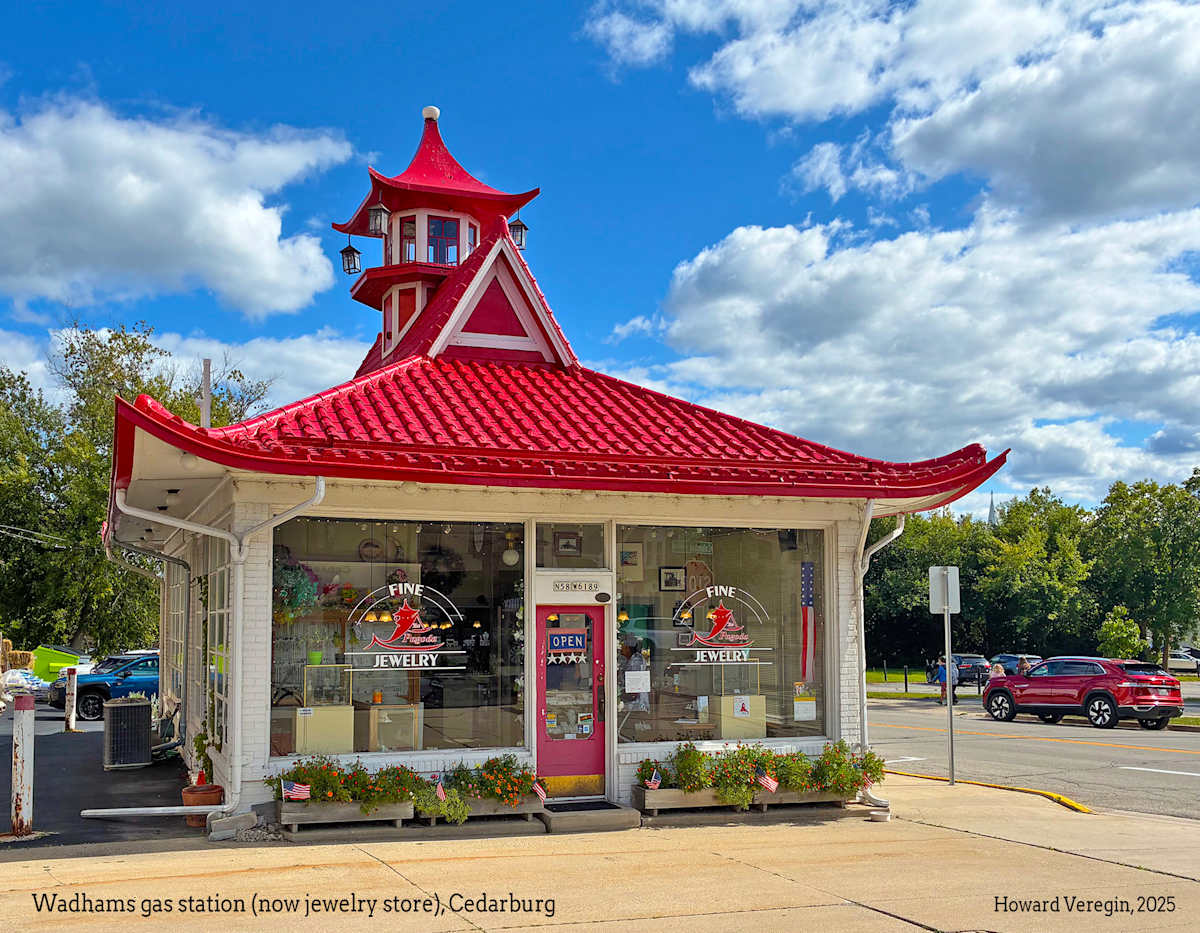The City of Cedarburg (Ozaukee County) has one of only a handful of remaining Wadhams pagoda-style gas stations, which once dotted the region. Capitalizing on the increased popularity of the private automobile in the early 1900s, the Wadhams Oil Company built more than a hundred stations between 1917 and 1930 in Wisconsin, Minnesota and Upper Michigan. [1][2]
Wadhams was one of the first oil companies to build roadside stations to pump gas directly into vehicles from underground tanks, making use of the newly invented gravity-fed gas delivery system. Before gas stations existed, customers purchased fuel at a petroleum depot, dry goods store or repair shop and then stored it at home. [3]
The Wadhams Oil and Grease Co. (later the Wadhams Oil Company) was headquartered in Milwaukee. It was founded in 1888 by Edward A. Wadhams, an entrepreneur whose interest in the oil industry led him to Pennsylvania and ultimately Wisconsin. The pagoda-style gas stations the company became known for were developed after Harger W. Dodge, Wadhams’ son-in-law, became vice president of the company after Wadhams’ death in 1916. [2]
Designed by Milwaukee architect Alexander Eschweiler, the pagoda design was meant to be visually striking, unique and easily recognizable. It was an early example of using architectural design for corporate branding, now standard practice for everything from fast-food restaurants to big box stores.
Eschweiler and his firm designed a number of prominent buildings in Milwaukee, including the Charles Allis Museum [4], the Milwaukee-Downer "Quad" (a set of four gothic buildings on the campus of UW-Milwaukee), Emanuel Philip School [5] and others.
All Wadhams gas stations were unique, but all had the distinctive red pressed-metal roof with upswept corners, and a white, yellow and black color scheme. Why the pagoda design in particular was chosen isn’t known, although there is general agreement that it derives from the popularity of “Oriental Exoticism,” as exemplified by the Japanese exhibit at the 1893 World Columbian Exposition in Chicago. [2][3]
At the time, other gas companies also adopted themed designs for their stations. Texaco’s was Spanish-influenced, Pure Oil’s was reminiscent of an English cottage and some Shell stations were built in the shape of sea shells. [3] Other fanciful designs of the 1920s and 30s included windmills, pyramids, castles, mosques and wigwams. [6]
In addition to their unusual gas stations, Wadhams developed innovative gasoline blends and an advertising campaign that positioned the company as a leader in automobile gasoline innovation. [7] In 1930, Wadhams was taken over by the Vacuum Oil Company, which later merged with Socony and eventually became Mobil.
The first Wadhams pagoda-style gas station – no longer in existence -- was built in 1917 in Milwaukee. [3] The city eventually had a least seven of the stations. [2] A Wadham’s station still stands at 1647 South 76th Street in West Allis (Milwaukee County). Built in 1927, It was restored in 2000 and listed in the National Register of Historic Places in 2004. [1][3]
Many Wadhams stations were simply demolished at a time when their unique history and significance were not appreciated. An example is the one that stood at 320 E. Mill Street in downtown Plymouth until 1954 [8]. By the 1970s, less than ten Wadham stations survived. [6]
The Wadhams station in Cedarburg is at the intersection of Columbia and Portland Roads, next to the Cedarburg Mill, built in 1855, which has been repurposed as an architectural and interior design studio. The gas station, built in 1926, is now a jewelry store.
The gas station is a significant building within the City of Cedarburg’s Washington Avenue National Register Historic District. Described as "Japanese Tea House" style in the Historic District Nomination, the Cedarburg Wadhams station is the only surviving station with a pagoda-style lantern on its roof. [6]
Will Kwik Trips (like Wadhams, also headquartered in Wisconsin) someday be revered as architecturally and culturally significant? This chain of gas stations/convenience stores carries the Wadhams legacy into the present, with an iconic design and a significant regional following. What about other examples, like Casey’s, RaceTrac, QuikTrip, Speedway and, of course, Buc-ees. One hundred years after the first Wadhams stations were built, these regional chains show the continued importance of architecture as an element of corporate branding.
Sources:
[1] Wisconsin Historical Society, 1647 South 76th Street. https://wisconsinhistory.org/Records/NationalRegister/NR2022
[2] City of Milwaukee, Final Historic Designation Study Report: Clinton Street Filling Station. https://city.milwaukee.gov/ImageLibrary/Groups/cityHPC/StudyReports/vticnf/ClintonStFillingStation1999.pdf
[3] National Register of Historic Places, Wadhams Gas Station. https://npgallery.nps.gov/GetAsset/706fc93b-5dbf-4768-b7cd-875b33f775d1
[4] Charles Allis Art Museum. https://www.charlesallis.org/the_mansion/history.php
[5] City of Milwaukee, Historic Designation Study Report, Emanuel Philipp School. https://www.milwaukee.gov/ImageLibrary/Groups/cityHPC/DesignatedReports/vticnf/Philipp.pdf
[6] National Register of Historic Places, Washington Avenue Historic District. https://npgallery.nps.gov/NRHP/GetAsset/NRHP/86000218_text
[7] Grease Monkey Garage, Wadhams Gasoline. https://www.greasemonkeyusa.com/blogs/motoropia/wadhams-gasoline
[8] Plymouth Chamber of Commerce, Wadhams Gas Station. https://plymouthwisconsin.com/murals/wadhams-gas-station/
